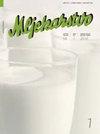用XRD、XPS和SEM对酸型和凝乳型驼奶酪蛋白进行了光谱表征,并对其乳化性能进行了研究
IF 1.1
4区 农林科学
Q3 AGRICULTURE, DAIRY & ANIMAL SCIENCE
引用次数: 0
摘要
酪蛋白是牛奶中的主要蛋白质,是天然乳化剂的一种可行的蛋白质来源,经常用于食品乳剂中。用x射线衍射(XRD)、x射线光电子能谱(XPS)和扫描电镜(SEM)对酸凝和凝血法制备的驼奶酪蛋白粉末进行了表征。这些方法分别提供了关于骆驼酪蛋白的晶体结构、表面组成、二级结构和微观结构的广泛信息。因此,在形态和表面组成方面出现了新的认识,这对于更好地理解乳化行为(即乳液随时间的稳定性和油滴大小)等功能特征是必要的。根据XPS测量,酸化产生的骆驼酪蛋白表面的O和C原子比例大于凝血酶引起的凝固,而N原子的百分比较低。两种凝固技术制备的骆驼酪蛋白表面氧碳比(O/C)具有可比性。但酶促混凝法的N/C比较高。研究结果表明,凝血酶诱导的凝血可能影响驼奶酪蛋白表面的C、O和N成分。此外,SEM和XRD数据表明,酸聚集影响酪蛋白胶束的形态,使其具有更多的β片状结构和光滑的结构。另一方面,凝乳骆驼酪蛋白具有多孔的胶体表面。观察到酪蛋白表面组成与酪蛋白粉末的乳化稳定性之间存在相关性,而凝血酶诱导凝血法明显改善了乳剂的液滴大小和稳定性。本文章由计算机程序翻译,如有差异,请以英文原文为准。
Spectroscopy characterization of acid and rennet camel milk caseins using XRD, XPS, and SEM and effects on their emulsifying properties
Casein, the main protein in milk, is a viable protein source for natural emulsifiers, which are frequently utilized in food emulsions. Camel milk casein powders obtained by acid and rennet coagulation were investigated and characterized using X-ray diffraction (XRD), X-ray photoelectron spectroscopy (XPS) and scanning electron microscopy (SEM). These methods gave extensive information regarding crystal structure, surface composition, and secondary and microstructures of the camel caseins, respectively. Therefrom new acknowledgements on morphology and surface composition have emerged, which is necessary to better understand functional characteristics such as emulsifying behaviour (i.e., emulsion’s stability over time and the oil droplet size). The O and C atomic proportions of camel casein surfaces generated by acidification were greater than those obtained through rennet-induced coagulation, whereas the percentage of N atomic was lower, according to XPS measurements. The oxygen to carbon (O/C) ratios on the surface of camel caseins produced by the two coagulation techniques were comparable. But, the enzymatic coagulation method yielded a high (N/C) ratio. The findings suggested that rennet-induced coagulation might influence the C, O, and N components on the surface of camel milk caseins. Furthermore, SEM and XRD data revealed that acid aggregation affected casein micelle’s morphology, resulting in more β-sheet and smooth structures. Rennet camel caseins, on the other hand, have a porous colloidal surface. A correlation between the casein surface composition and the emulsifying stability of the casein powders was observed, whereas the droplet size and stability of emulsions were strongly improved by the rennet-induced coagulation method.
求助全文
通过发布文献求助,成功后即可免费获取论文全文。
去求助
来源期刊

Mljekarstvo
Agricultural and Biological Sciences-Animal Science and Zoology
CiteScore
1.90
自引率
41.70%
发文量
18
审稿时长
12 weeks
期刊介绍:
Mljekarstvo is an open access, peer-reviewed international quarterly scientific journal. The first issue was published in 1951, by the Croatian Dairy Operators'' Association (today: Croatian Dairy Union, publisher). In a paper at a Union conference held 28 October 1951 in Zagreb it was said: "Our desire is that this magazine does not meet the fate of its predecessors, but that it continues to reflect the creative efforts and to provide guidelines for the producers as well as all other operators employed in the dairy industry."
It is our pleasure today to say that wishes of the enthusiasts who attended the conference have come true, and the magazine Mljekarstvo during the last six decades was a reflection of the creative efforts of numerous dairy scientists and experts, and through its texts it served as a guideline in improving production and processing of milk and dairy products. Mljekarstvo has been following all the achievements of the dairy profession in Croatia, and it also gives the short surveys of world achievements. The result of the research of local and foreign scientists and experts always find their place in the magazine Mljekarstvo. It has been edited by our outstanding dairy experts employed at colleges, research institutions and dairy companies.
 求助内容:
求助内容: 应助结果提醒方式:
应助结果提醒方式:


